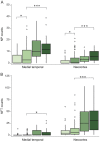Self-reported memory complaints: implications from a longitudinal cohort with autopsies
- PMID: 25253756
- PMCID: PMC4189103
- DOI: 10.1212/WNL.0000000000000856
Self-reported memory complaints: implications from a longitudinal cohort with autopsies
Abstract
Objective: We assessed salience of subjective memory complaints (SMCs) by older individuals as a predictor of subsequent cognitive impairment while accounting for risk factors and eventual neuropathologies.
Methods: Subjects (n = 531) enrolled while cognitively intact at the University of Kentucky were asked annually if they perceived changes in memory since their last visit. A multistate model estimated when transition to impairment occurred while adjusting for intervening death. Risk factors affecting the timing and probability of an impairment were identified. The association between SMCs and Alzheimer-type neuropathology was assessed from autopsies (n = 243).
Results: SMCs were reported by more than half (55.7%) of the cohort, and were associated with increased risk of impairment (unadjusted odds ratio = 2.8, p < 0.0001). Mild cognitive impairment (dementia) occurred 9.2 (12.1) years after SMC. Multistate modeling showed that SMC reporters with an APOE ε4 allele had double the odds of impairment (adjusted odds ratio = 2.2, p = 0.036). SMC smokers took less time to transition to mild cognitive impairment, while SMC hormone-replaced women took longer to transition directly to dementia. Among participants (n = 176) who died without a diagnosed clinical impairment, SMCs were associated with elevated neuritic amyloid plaques in the neocortex and medial temporal lobe.
Conclusion: SMC reporters are at a higher risk of future cognitive impairment and have higher levels of Alzheimer-type brain pathology even when impairment does not occur. As potential harbingers of future cognitive decline, physicians should query and monitor SMCs from their older patients.
© 2014 American Academy of Neurology.
Figures


Comment in
-
Self-reported memory complaints: Implications from a longitudinal cohort with autopsies.Neurology. 2015 Jun 9;84(23):2384. doi: 10.1212/WNL.0000000000001677. Neurology. 2015. PMID: 26054896 No abstract available.
-
Author Response.Neurology. 2015 Jun 9;84(23):2384. Neurology. 2015. PMID: 26251864 No abstract available.
Similar articles
-
Subjective Memory Complaints are Associated with Incident Dementia in Cognitively Intact Older People, but Not in Those with Cognitive Impairment: A 24-Month Prospective Cohort Study.Am J Geriatr Psychiatry. 2017 Jun;25(6):607-616. doi: 10.1016/j.jagp.2016.12.008. Epub 2017 Jan 4. Am J Geriatr Psychiatry. 2017. PMID: 28216174
-
Memory complaints and risk of cognitive impairment after nearly 2 decades among older women.Neurology. 2015 Nov 24;85(21):1852-8. doi: 10.1212/WNL.0000000000002153. Epub 2015 Oct 28. Neurology. 2015. PMID: 26511452 Free PMC article.
-
Risk of dementia and mild cognitive impairment in older people with subjective memory complaints: meta-analysis.Acta Psychiatr Scand. 2014 Dec;130(6):439-51. doi: 10.1111/acps.12336. Epub 2014 Sep 13. Acta Psychiatr Scand. 2014. PMID: 25219393 Review.
-
Association of subjective memory complaint and depressive symptoms with objective cognitive functions in prodromal Alzheimer's disease including pre-mild cognitive impairment.J Affect Disord. 2017 Aug 1;217:24-28. doi: 10.1016/j.jad.2017.03.062. Epub 2017 Mar 30. J Affect Disord. 2017. PMID: 28380342
-
Subjective memory complaints and cognitive impairment in older people.Dement Geriatr Cogn Disord. 2006;22(5-6):471-85. doi: 10.1159/000096295. Epub 2006 Oct 16. Dement Geriatr Cogn Disord. 2006. PMID: 17047326 Review.
Cited by
-
Feeling Older and the Development of Cognitive Impairment and Dementia.J Gerontol B Psychol Sci Soc Sci. 2017 Oct 1;72(6):966-973. doi: 10.1093/geronb/gbw085. J Gerontol B Psychol Sci Soc Sci. 2017. PMID: 27436103 Free PMC article.
-
Memory Complaint Is a Surrogate for Memory Decline in the Middle-Aged: A Register-Based Study.J Clin Med. 2019 Nov 7;8(11):1900. doi: 10.3390/jcm8111900. J Clin Med. 2019. PMID: 31703376 Free PMC article.
-
Increasing Inaccuracy of Self-Reported Subjective Cognitive Complaints Over 24 Months in Empirically Derived Subtypes of Mild Cognitive Impairment.J Int Neuropsychol Soc. 2018 Sep;24(8):842-853. doi: 10.1017/S1355617718000486. J Int Neuropsychol Soc. 2018. PMID: 30278855 Free PMC article.
-
Memory and Confusion Complaints in Visually Impaired Older Adults: An Understudied Aspect of Well-Being.Gerontol Geriatr Med. 2019 Jan 8;5:2333721418818944. doi: 10.1177/2333721418818944. eCollection 2019 Jan-Dec. Gerontol Geriatr Med. 2019. PMID: 30671493 Free PMC article.
-
Subjective memory complaints in Italian elderly with mild cognitive impairment: implication of psychological status.Neurol Sci. 2016 Jul;37(7):1153-7. doi: 10.1007/s10072-016-2553-6. Epub 2016 Mar 30. Neurol Sci. 2016. PMID: 27025607 Free PMC article.
References
-
- van Harten AC, Visser PJ, Pijnenburg YA, et al. Cerebrospinal fluid Aβ42 is the best predictor of clinical progression in patients with subjective complaints. Alzheimers Dement 2013;9:481–487 - PubMed
-
- Wang L, Van Belle G, Crane PK, et al. Subjective memory deterioration and future dementia in people aged 65 and older. J Am Geriatr Soc 2004;52:2045–2051 - PubMed
-
- Geerlings MI, Jonker C, Bouter LM, Adèr HJ, Schmand B. Association between memory complaints and incident Alzheimer's disease in elderly people with normal baseline cognition. Am J Psychiatry 1999;156:531–537 - PubMed
-
- Jungwirth S, Zehetmayer S, Weissgram S, Weber G, Tragl KH, Fischer P. Do subjective memory complaints predict senile Alzheimer dementia? Wien Med Wochenschr 2008;158:71–77 - PubMed
Publication types
MeSH terms
Substances
Grants and funding
LinkOut - more resources
Full Text Sources
Other Literature Sources
Medical
Research Materials
Miscellaneous
